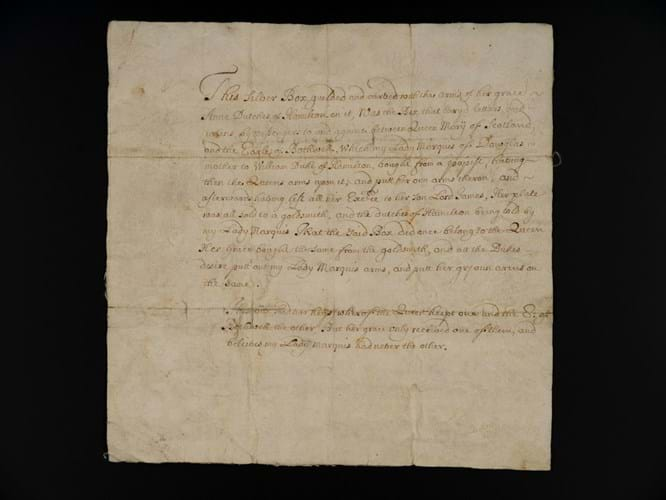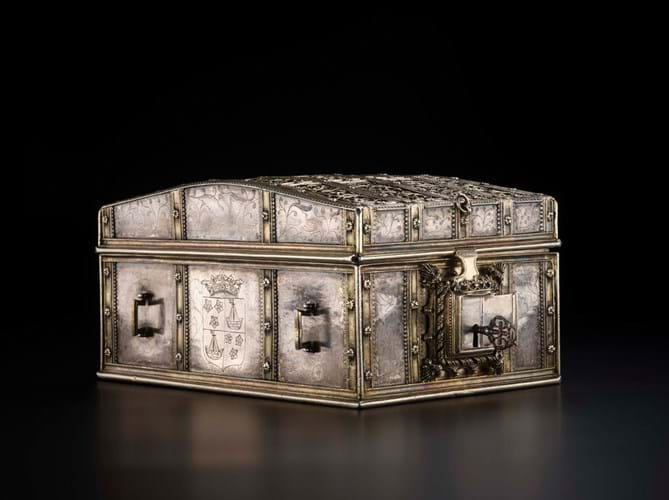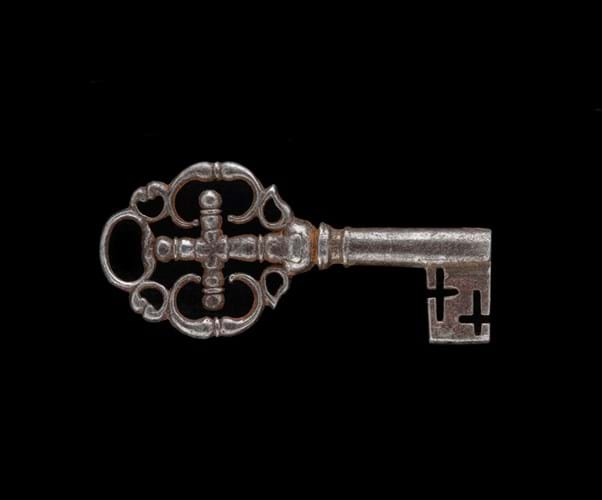
Dr Anna Groundwater, principal curator at National Museums Scotland, with the silver casket believed to have belonged to Mary, Queen of Scots. Photo: Stewart Attwood.
Made in Paris, probably between 1493-1510, it is a rare example of early French silver.
According to a handwritten note from the late 17th century stored with the casket, its previous owner (Mary, Marchioness of Douglas) believed it to belong to Mary Queen of Scots.
The note records the belief that this is the casket which played a dramatic role in Mary’s downfall when, in December 1568, a similar casket was produced at a hearing ordered by Elizabeth I against Mary at Westminster. This contained what have become known as the Casket Letters. These love poems and letters, allegedly from Mary to her third husband, the Earl of Bothwell, implicated them both in a conspiracy to murder her second husband, Lord Darnley.

A note recording the belief that the silver casket belonged to Mary, Queen of Scots. Image: National Museums Scotland.
It is thought that the casket was given to Mary by her first husband, François II of France, and came to Scotland with her in 1561 after his death in 1560.
A casket first appears in the records following Mary’s arrest in 1567 by the rebellious Confederate Lords, when it was discovered in the hands of Lord Bothwell’s servant. It was brought before the Scottish Privy Council where its lock was struck off to reveal its contents. However, a year later, when the Earl of Moray dramatically produced the same casket at Westminster, it now contained the damning Casket Letters.
The authorship of the letters remains a subject of debate but it is widely thought that they were doctored. Following the hearing at Westminster, Mary remained in English captivity for 19 years, until she was executed in 1587 for her involvement in the Babington Plot to assassinate Elizabeth I.
The casket is believed to have been purchased c.1674 by Anne, Duchess of Hamilton (who purchased it from Mary, Marchioness of Douglas on the understanding that it once belonged to Mary, Queen of Scots).
It stayed in the Dukes of Hamilton family for three centuries, passing into the ownership of Lennoxlove House, a historic East Lothian house and the seat of the Duke of Hamilton and Brandon, by the mid-20th century.
The £1.8m sale was managed by Sotheby’s with funding from the National Heritage Memorial Fund, Art Fund, the Scottish Government and several trusts, foundations and individual donors. Among the donations was £810,000 from the National Heritage Memorial Fund and £200,000 from the Scottish Government’s National Museums Scotland Acquisitions Fund.
A spokesperson for Lennoxlove House said: “Although we are sad that the casket is leaving, its sale will enable the long-term maintenance of the house and its contents.”
Dr Chris Breward, director of National Museums Scotland, said: “This extraordinary casket is truly one of Scotland’s national treasures. Venerated as a relic of Mary for centuries, it is believed to represent a momentous and disastrous moment in her turbulent life.”







